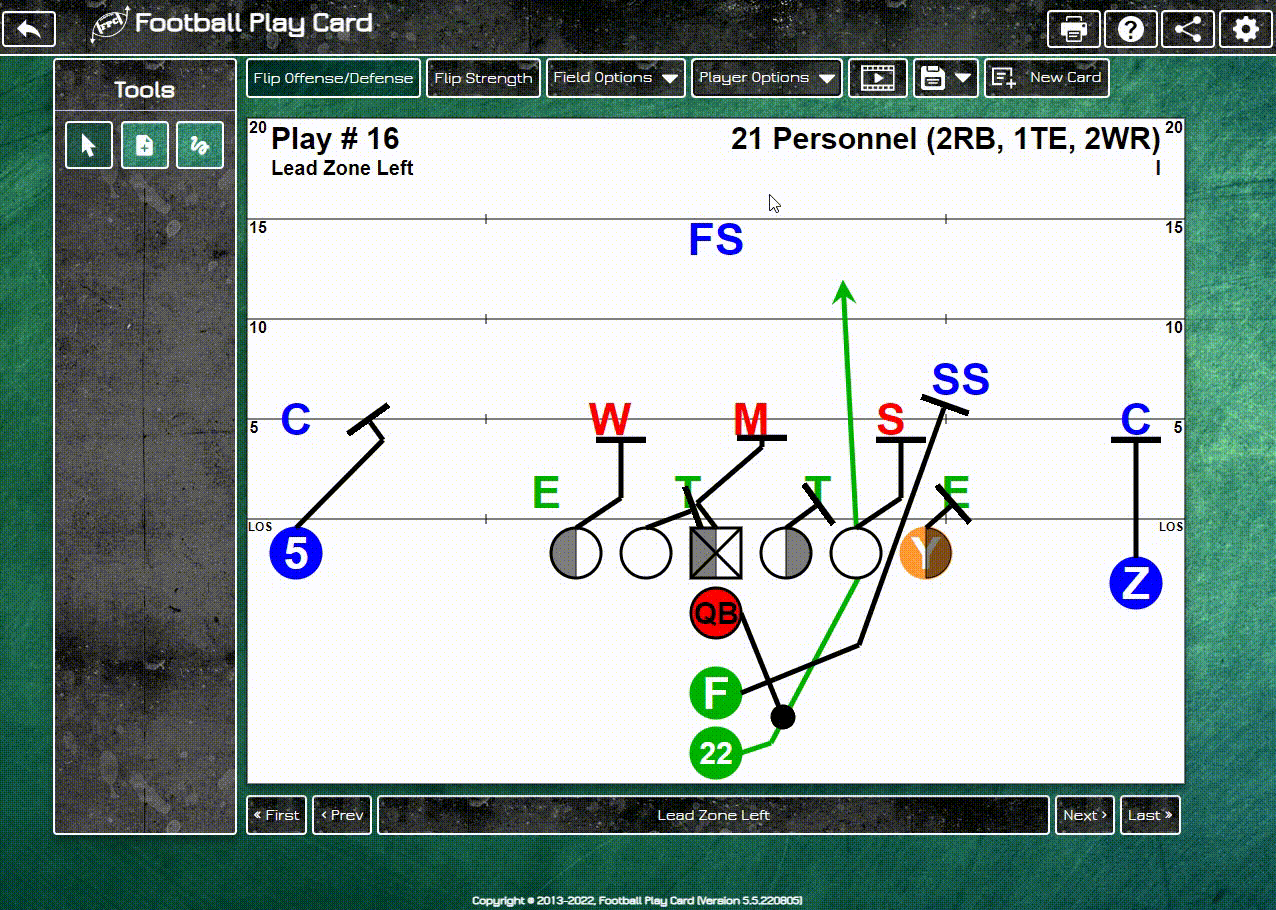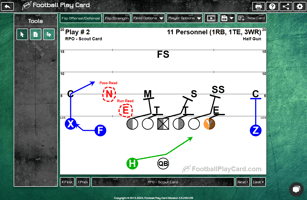If you create play cards with an offense, front, or coverage that is not included in the system...
The Quintessential Guide to Run-Pass Option (RPO) Plays
Run-Pass Option (RPO) plays have become a cornerstone of modern football, offering dynamic flexibility that challenges defenses and maximizes offensive efficiency. This comprehensive guide is designed to equip coaches at all levels with the knowledge and strategies necessary to effectively implement RPO plays. From the basics to advanced concepts, this guide covers everything you need to know about RPOs and how to leverage them to gain a competitive edge.
Understanding RPOs
What is an RPO?
An RPO is a play in which the quarterback has the option to hand the ball off to a running back, pass to a receiver, or keep the ball and run themselves, all based on the defense’s reaction post-snap. This decision is made in real-time, giving the offense a strategic advantage.
Why Use RPOs?
- Flexibility: Adapt to defensive schemes on the fly.
- Confusion: Keep defenses guessing and disrupt their assignments.
- Efficiency: Maximize yardage by exploiting defensive weaknesses.
- Versatility: Applicable in various offensive schemes, from spread to power formations.
Core Components of RPO Plays
1. Pre-Snap Reads
Defensive Alignment: Identify the number of defenders in the box. A high defender count suggests a favorable passing situation, while fewer defenders indicate a better running opportunity.
Coverage Recognition: Understand if the defense is playing zone or man coverage. This influences the type of pass routes that will be effective.
2. Post-Snap Reads
Key Defender: Typically a linebacker or safety whose movement determines the play. The quarterback reads this player to decide whether to hand off, pass, or run.
Decision-Making: The quarterback’s ability to quickly read and react to the key defender’s actions is crucial. This requires practice and a thorough understanding of the play's design.
Types of RPO Plays
1. Inside Zone RPO
- Read: Linebacker or edge defender.
- Options: Hand off to the running back for an inside zone run, keep and run, or throw a quick pass if the read defender crashes.
- Coaching Tip: Emphasize quick decision-making and the importance of ball security during the mesh point.
2. Outside Zone RPO
- Read: Outside linebacker or safety.
- Options: Hand off for an outside zone run, keep and run, or pass to a receiver on a quick out or bubble screen.
- Coaching Tip: Ensure the offensive line understands their blocking assignments to create clear running lanes.
3. Bubble Screen RPO
- Read: Linebacker or safety.
- Options: If the defender moves to stop the run, throw the bubble screen. If the defender stays, hand off or keep the ball.
- Coaching Tip: Work on timing between the quarterback and receivers to ensure the screen is executed efficiently.
4. Slant RPO
- Read: Linebacker or slot defender.
- Options: If the read defender fills the run gap, throw the slant. If not, proceed with the run.
- Coaching Tip: Train receivers to run precise routes and quarterbacks to deliver accurate passes.
Designing Effective RPO Plays
1. Personnel and Formation
- Spread Formations: Create space and force defenses to reveal their intentions.
- Tight Formations: Better for short-yardage situations and power runs.
- Versatile Players: Use players who can effectively execute both run and pass plays.
2. Practice and Repetition
- Repetition: Ensure your quarterback and key players are comfortable with the reads and execution. Repetition builds muscle memory and confidence.
- Simulate Different Defenses: Prepare for various defensive looks to ensure your players can adapt on the fly.
3. Communication
- Code Words and Hand Signals: Develop a system for quick and clear communication to make adjustments at the line of scrimmage.
- Film Study: Use video analysis to help players understand their roles and improve their decision-making.
Drills to Master RPOs
1. Read and React Drills
- Setup: Use a defender to simulate the key read. Have the quarterback practice making quick decisions based on the defender's actions.
- Focus: Emphasize quick reads and proper mechanics.
2. Mesh Point Drills
- Setup: Practice the exchange between the quarterback and running back. Work on both handing off and pulling back for a pass.
- Focus: Smooth and secure exchanges to minimize turnovers.
3. Receiver Drills
- Setup: Run routes that are commonly paired with RPO plays. Emphasize quick cuts and catching in stride.
- Focus: Route precision and timing with the quarterback.
4. Live Scrimmages
- Setup: Incorporate live scrimmages to simulate game conditions.
- Focus: Real-time decision-making and execution under pressure.
Advanced RPO Strategies
1. Double Reads
- Concept: Incorporate two read defenders to further complicate the defense's response.
- Application: Can be used to create multiple layers of options, forcing defenses to commit and then exploiting the vacated area.
2. Motion and Shifts
- Concept: Use pre-snap motion and shifts to confuse defenses and create mismatches.
- Application: Motion can reveal defensive coverage and force defenders out of position.
3. Play-Action RPOs
- Concept: Combine traditional play-action with RPO principles to deceive the defense.
- Application: Effective in keeping linebackers and safeties guessing, thus opening up passing lanes.
Benefits of RPOs
- Keeps Defenses Honest: Forces defenses to play balanced, reducing their ability to load the box or focus solely on pass coverage.
- Exploits Mismatches: Identifies and attacks the weakest points of the defense.
- Maximizes Efficiency: Increases offensive efficiency by creating favorable scenarios on each play.
How Football Play Cards Can Help
Football play cards are invaluable tools for coaches looking to implement RPOs effectively. These cards offer visual representations of plays, aiding in the teaching and learning process. Here’s how they can help:
- Visualization: Players can see the exact positioning and movement required, making it easier to understand and execute complex plays.
- Repetition: Use play cards to run through scenarios repeatedly, reinforcing learning.
- Adjustment: Quickly modify plays on the fly and communicate changes efficiently to players.
Conclusion
The Run-Pass Option (RPO) is a powerful tool in any coach’s arsenal, providing flexibility, efficiency, and a strategic advantage on the field. By understanding the core components, types, and advanced strategies of RPOs, coaches can elevate their offensive game plan and keep defenses perpetually off-balance. Utilizing tools like football play cards can further enhance the learning and execution of these plays, ensuring your team is well-prepared to dominate the competition. Embrace the RPO, master its nuances, and watch your offense flourish.


